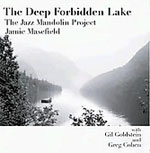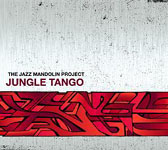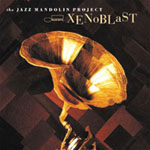Home » Jazz Articles » Interview » Jamie Masefield: Re-Invention
Jamie Masefield: Re-Invention
The Tolstory project is to create a new vehicle for JMP to play music within and so I want to play as much music as possible.
 Jamie Masefieldâ????s professional independence is matched by his artistic integrity, so the recent premiere of his conception of Tolstoyâ????s "How Much Land Does a Man Need" is another innovative change of direction for the leader of The Jazz Mandolin Project.
Jamie Masefieldâ????s professional independence is matched by his artistic integrity, so the recent premiere of his conception of Tolstoyâ????s "How Much Land Does a Man Need" is another innovative change of direction for the leader of The Jazz Mandolin Project. This new work of Masefieldâ????s is an ambitious project involving narration, video and a new original score to relate one of Tolstoyâ????s most famous short stories. In the course of the presentation, Masefield steers his group away from the concert stage proper and moves it in front of a movie screen to shed light on classic literature and the ethics of Leo Tolstoy, who has often received the title as "the greatest storyteller in modern history" (1828-1910).
Funded in part by a Creation Grant from the Vermont Council of the Arts and the National Endowment for the Arts, the new JMP piece follows closely on the heels of last yearâ????s The Deep Forbidden Lake (Lenapee, 2005), itself a marked departure for Masefield in the revolving set of players under the JMP moniker. In contrast to the freewheeling improvisational bent of earlier albums like Xeno- blast (Blue Note, 2000) and the world beat rhythms of Jungle Tango (Lenapee, 2003), the latest JMP studio work is chamber music of sorts, the quiet acoustic ruminations of mandolin. piano and double bass on a diverse selection of material ranging from the works of Neil Young and Radiohead to Django Rheinhardt and Ornette Coleman.
Jamie Masefield established his roots in the Vermont music scene over a decade ago and they remain firm to this day. He formed The Jazz Mandolin Project in 1993 more as an exploratory musical concept than a band which, over time, has been comprised of varying lineups of musicians (including at various points, Jon Fishman.)
JMP has since toured regularly appearing in clubs, theaters and festivals throughout the United States and the European continent. In addition to this consistent activity, the mandolinist often performs as a duo with Smokinâ???? Grass leader Doug Perkins, has arranged limited engagements of programs of Django Reinhardtâ????s music and regularly guests on stage with musicians visiting Vermont. Masefield debuted his most recent project in Burlington Vermont's FlynnSpace.
All About Jazz: When we first talked about this interview... you had talked about how "the gears and direction" had changed for you. I wonder what you meant by that—if you were referring just to the Tolstoy presentation at FlynnSpace or was there something more going on than that?
 Jamie Masefield: I was referring more to the Tolstoy thing, but it's all a part of the same [thing]. After being on the road for so long, I started thinking of different things that we could do, different things that I could learn different environments for the music. I felt that it would be positive to have some change and challenges. I also wanted to do something that had little bit of a message to it with some intellectual content. With so many things going on in the world it seems a little indulgent...[and] I'm trying to say this as politically correctly as possible...I think the general climate we perform in is a fairly indulgent environment where everyone's wanting to have a good time—and I want to have a good time too'"[but] I have really been wanting to do something that had a message that would engage people in thoughtful conversations.
Jamie Masefield: I was referring more to the Tolstoy thing, but it's all a part of the same [thing]. After being on the road for so long, I started thinking of different things that we could do, different things that I could learn different environments for the music. I felt that it would be positive to have some change and challenges. I also wanted to do something that had little bit of a message to it with some intellectual content. With so many things going on in the world it seems a little indulgent...[and] I'm trying to say this as politically correctly as possible...I think the general climate we perform in is a fairly indulgent environment where everyone's wanting to have a good time—and I want to have a good time too'"[but] I have really been wanting to do something that had a message that would engage people in thoughtful conversations.
AAJ: It's easy to become insular especially if you get involved in music professionally or even just on an amateur level; you find yourself slipping into a somewhat compartmentalized way of thinking. I think just in general if we don't all at one time or another make a gesture to show that we're all connected to the world around us, everyone presumes we have no connection to it whatsoever, that we're all going on in our blissfully ignorant way.
JM: Right... I found myself asking myself "What else can I do? What new things are there to accomplish?" and in asking myself those questions, I came to the Tolstoy project which has provided, no not provided, it really is the answer to a lot of the questions and challenges I posed to myself. I've learned so much by putting this thing together and it's kind of put me in a different environment that I really want to be in. Performing the premier thing at the Flynn was really nice: it was great to be at the Flynn—we did all of our rehearsing there—and to be in a really nice listening environment for people.
 AAJ: That's always been a terrific pleasure to hear and see musicians perform at FlynnSpace. It's a really great place to be a part of music. I have to tell you I found the question and answer session after the Saturday night FlynnSpace performance quite enlightening. When you talked about how much you learned, and just now thinking back on how you talked about using computer software to work on the music, it sounded like that, in combination with the video part of the project, just took you in a whole other realm altogether apart from the working musician role you'd been in for so long.
AAJ: That's always been a terrific pleasure to hear and see musicians perform at FlynnSpace. It's a really great place to be a part of music. I have to tell you I found the question and answer session after the Saturday night FlynnSpace performance quite enlightening. When you talked about how much you learned, and just now thinking back on how you talked about using computer software to work on the music, it sounded like that, in combination with the video part of the project, just took you in a whole other realm altogether apart from the working musician role you'd been in for so long.
JM: That is exactly right. And I am not a computer whiz. I think if someone had heard that I had done that stuff, they would think these things come naturally to me, but they don't. It's actually a really painful learning curve.
AAJ: I got that impression from the look on your face as you talked about it. That it was not actually frustrating but a healthy growing pain. Shall we call it that?
JM: That's exactly what it was. And I wrote music that I never would've written if I wasn't writing it on the computer. Being able to write out a trumpet line and write out the upright bass bowing the notes and then listen to what I wrote, then go back and edit and hear the slight changes I had made with my editing really helped craft things.
AAJ: I'll bet it did. It's interesting to hear you say that though because as I was listening to you and the band play that night, I thought "Wow, with all the new things going on here in terms of the multimedia, this is vintage Jazz Mandolin Project music the way I've always enjoyed it." So if working with software made it different, it almost sounded like it helped you be more yourself—if that doesn't sound too lame.
JM: Well, I'd take that as a compliment. That's actually really good for me to hear. You know of course the music was also inspired by what was happening on the screen, so I'd get my inspirations from that and start working away at chords and stuff. It's good to hear that it didn't get too mechanical going through a new writing process.
AAJ: No, it didn't strike me that way at all. In fact, when I listen to The Jazz Mandolin Project, no matter what line-up it is, no matter whether it's live or on a CD, I very often get images in my head of wide-open spaces, sky and land off in the distant horizon. Not surprisingly that's what much of the video footage was. Which lent a lot of continuity to what you were doing that night. It wasn't a wholly new thing for you—it seemed to be a logical extension to what you'd been doing over the last ten years or so.
JM: I'm glad you think so. I felt the same way—that the landscapes certainly seemed to be playing a role in all kinds of different ways.

Sean Dixon, Jamie Masefield, Michael O'Brien, Michael "Mad Dog" Mavridoglou
AAJ: How do think the shows went at FlynnSpace? I only saw the Saturday night one and I didn't read anything about it or the Sunday night one anywhere else...were you pleased with how things went?
JM: I was really pleased. You know the amazing thing in this process for me was that I really didn't know how this thing would turn out. I was kind of clueless as everyone else and I had to keep working and working and working but I didn't really have a chance to see how it would work until the guys actually arrived in Burlington and we had two days of rehearsal to have the full band play while the footage was going by. Really things went as smoothly as I could've hoped for—there weren't any technical glitches and we didn't make any glaring mistakes, I don't think, in the way we played it. Everything went pretty smoothly.
The feedback I got after the first night was that people really wanted more music and that was great for me because I want to play more music too. I had gone through a process in my head where I had thought it would be better for the most part if we didn't play while the narrator was speaking because I didn't want people to get sidetracked, you know watching the drummer and then miss an important line where she might say a critical thing in the story and then they might be clueless after that.
But I gathered from talking to people afterwards that Americans are so movie- oriented that they're really good multi-taskers when they're watching something: everyone was saying "No, no, we'll hear the story and we want more music." So, I said "Great" and for the second night, we did something you probably would've dug: in the areas in the narration that are kind of long without any music, we chose a person to solo and improvise underneath her voice.
I thought it worked really well especially for me because I had been working on the video for so long that I knew all of her vocal inflections where she stops and starts—there would be a little pause here—so I had a lot of fun playing the mandolin along with her voice and trying to be sing-songy along with her.
AAJ: Well that's fascinating to hear you say that because that to me, while I'm not a real fan of jazz vocalists, that would seem to be the definition of playing with a jazz singer, that is, to harmonize with them knowing their inflections and either following them or counterpointing them or dancing with them, in a way.
JM: That was really kind of what I was enjoying doing. I knew that her voice would say (sings)..da da da da da da da And Iâ????d play ( sings) de de de de de de de. It was fun.
 AAJ: I have to tell you that the show I saw left me a little hungry for more music like it did a lot of people. I guess I had some expectation that the presentation would go in such a way that here would be narration, and then there would be video, and then there would be just as many, or just as lengthy interludes, of you guys playing, perhaps fading in and out of the other media. And that didn't happen as often or as much as I might've liked. Now I don't know if that was a misperception on my part or a misconception on my part or whether I just dig hearing you guys play a lot.
AAJ: I have to tell you that the show I saw left me a little hungry for more music like it did a lot of people. I guess I had some expectation that the presentation would go in such a way that here would be narration, and then there would be video, and then there would be just as many, or just as lengthy interludes, of you guys playing, perhaps fading in and out of the other media. And that didn't happen as often or as much as I might've liked. Now I don't know if that was a misperception on my part or a misconception on my part or whether I just dig hearing you guys play a lot.
JM: In the program notes, I specifically wrote that there are three media and that the story was the most important. And so the music and the visuals were supportive of the story in my mind. That's what I wanted to get across most importantly. However, the show was only 55 minutes long and my intention now is to expand it to at least 70 minutes. The story is already told in 55, so I see an extra 15, maybe 20 minutes being all music and visuals. So I do think we will get to the zone where you were craving, that I crave as well. Really one of the major reasons for drumming up this concept is to create a new vehicle for JMP to play music within and so I want to play as much music as possible.
AAJ: Well that's great to hear. I didn't want to jump to a conclusion and read too much into the project itself or what you were saying or any of the comments you were making during the question and answer session Saturday night. But it almost seemed like what moved you to do this project was some measure of---and correct me if I'm wrong---frustration with just playing music with the band?
JM: Well, kind of like that. It's a lot of things, but it's an effort to move the music out of sticky-floored rock clubs and into nice listening environments. And that doesn't mean that I don't like stocky-floored rock clubs; it means that I've been living in them for thirteen years and I'd like to vary my life a little.
AAJ: I can understand that...
JM: So it was for that, and as I mentioned before, to do something with intellectual content, to do something with different media: visuals and literature, to try to engage a wide audience. I'm very fortunate and grateful for the young people who find something in JMP—I really am grateful—I think there are elements of JMP that would appeal to lots of other kinds of people and I felt like if I could attach it to some great literature that I could reach some more of those people that I want to reach.
 AAJ: I agree. That's a pretty laudable ambition too and one that doesn't lend itself to an easy compromise just for the sake of playing to a lot of people. I don't want to sound patronizing when I say that, but one thing I've long admired about you and the band is how independent you are and how you've maintained your integrity and not literally or figuratively in any way sold out. So that's good to hear.
AAJ: I agree. That's a pretty laudable ambition too and one that doesn't lend itself to an easy compromise just for the sake of playing to a lot of people. I don't want to sound patronizing when I say that, but one thing I've long admired about you and the band is how independent you are and how you've maintained your integrity and not literally or figuratively in any way sold out. So that's good to hear.
JM: I don't know as we've ever had an opportunity to sell out [laughs].
AAJ: Do you have any kind of contract with a label right now or are you still wholly independent?
JM: No, I'm independent and I really think that that's the way it'll be from here on out. I mean things have changed so much, as you know, with the record industry and I'm much more satisfied paying all the costs myself putting it out myself and not getting involved in somecorporation's accounting abilities.
AAJ: Just to get back to the Tolstoy project: do you still have plans to expand that as you mentioned a minute ago and take it on the road for at least limited engagements in other cities?
JM: Ever since the premiere, some video people and myself have been making a promotional DVD about what this thing is. Because it is hard to explain to people—there are a lot of different facets—so we have been making a promotional DVD and we'll be handing it over to my booking agents and they'll have the proper tools to put it out to performing arts centers around the country and see if they'd like to have us perform. So I'm really focused on that project right now and if some festival or some place wants to have JMP to come do a concert, in some special situation, I'm delighted to go play. But for the time being, I really want to focus on the Tolstoy thing and try to perform in front of people and get that give-and-take discussion afterwards, get people thinking about some different things. I think it's a fresh offering.
AAJ: It no doubt is. You mentioned a couple things that came to mind as I was looking forward to the interview today—one of which was your mention of preparing a DVD of the Tolstoy presentation—and also too, as I notice the festivals announcing their lineups this summer, whether Jazz Mandolin Project or you solo or maybe with Doug Perkins would do any of those dates. You sound like you're pretty much focused on the Tolstoy thing as this point though.
 JM: Well I'm focused on it but the truth of the matter is that that hasn't asked we many places to perform. I'm trying to make the best use of my time by creating something new.
JM: Well I'm focused on it but the truth of the matter is that that hasn't asked we many places to perform. I'm trying to make the best use of my time by creating something new.
AAJ: As we talk about that, and also refer to the more open-ended approach, I'm thinking of the last studio album you did, The Deep Forbidden Lake, was quite a bit different than the other CDs you did in that it was more structured and more formally arranged. It sort of set the stage for the Tolstoy project; do you see it that way in retrospect or am I just way off base?
JM: I think that that's a coincidence a little bit. I mean really what these things are, are me looking at my checklist of things to do. Deep Forbidden Lake was at the top of the list of my things to do, which was put out an album of songs that I just think are fantastic, that aren't mine. To step away from my compositions and pour my energy into someone else's compositions. And I also wanted to play something that was really quiet that didn't have drums. I wanted to play with Gil Goldstein in a more intense situation; he played on several tracks on Jungle Tango, but I felt like I didn't really. He was under utilized in that project and I felt like there was so much I could learn from him that I wanted to do something much more really engaging with him. So Deep Forbidden addressed all so those interests and then this Tolstoy project engages a whole bunch of other interests that I think we've touched upon in this conversation.
AAJ: it sounds like you're very excited and very focused on what you're doing right now.
JM: I hope maybe within a year or so you might get a chance to see the Tolstoy show again and see what kind of development and progress that's had since the premiere.
Discography
The Jazz Mandolin Project, The Deep Forbidden Lake (Lenapee/KDE, 2005)
The Jazz Mandolin Project, Jungle Tango (Lenapee, 2003)
The Jazz Mandolin Project, After Dinner Jams (Independent, 2001)
The Jazz Mandolin Project, Xenoblast (Blue Note, 2000)
The Jazz Mandolin Project, Tour de Flux (Accurate Records, 1999)
The Jazz Mandolin Project, The Jazz Mandolin Project (Accurate Records, 1996)
Related Articles:
The Jazz Mandolin Project: Mixed Media, Mixed Messages (Concert Review, 2006)
The Jazz Mandolin Project at Higher Ground (Concert Review, 2004)
Jazz Mandolin Project (Concert Review, 2004)
Photo Credit: Michelle Sammartino.
< Previous
In Her Eyes
Next >
Bruxin'
Comments
About Jamie Masefield
Instrument: Mandolin
Related Articles | Concerts | Albums | Photos | Similar ToTags
For the Love of Jazz
 All About Jazz has been a pillar of jazz since 1995, championing it as an art form and, more importantly, supporting the musicians who create it. Our enduring commitment has made "AAJ" one of the most culturally important websites of its kind, read by hundreds of thousands of fans, musicians and industry figures every month.
All About Jazz has been a pillar of jazz since 1995, championing it as an art form and, more importantly, supporting the musicians who create it. Our enduring commitment has made "AAJ" one of the most culturally important websites of its kind, read by hundreds of thousands of fans, musicians and industry figures every month.






















